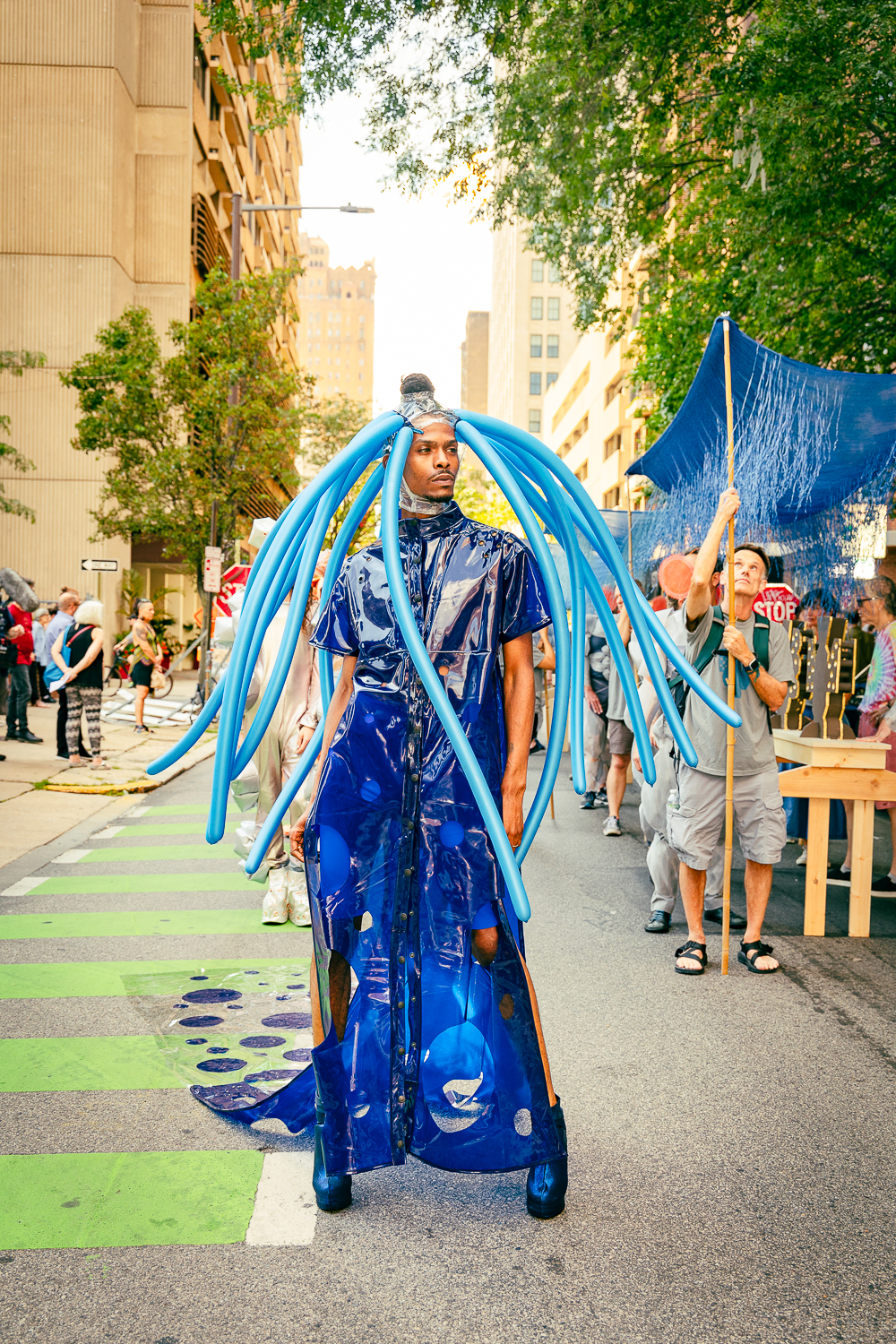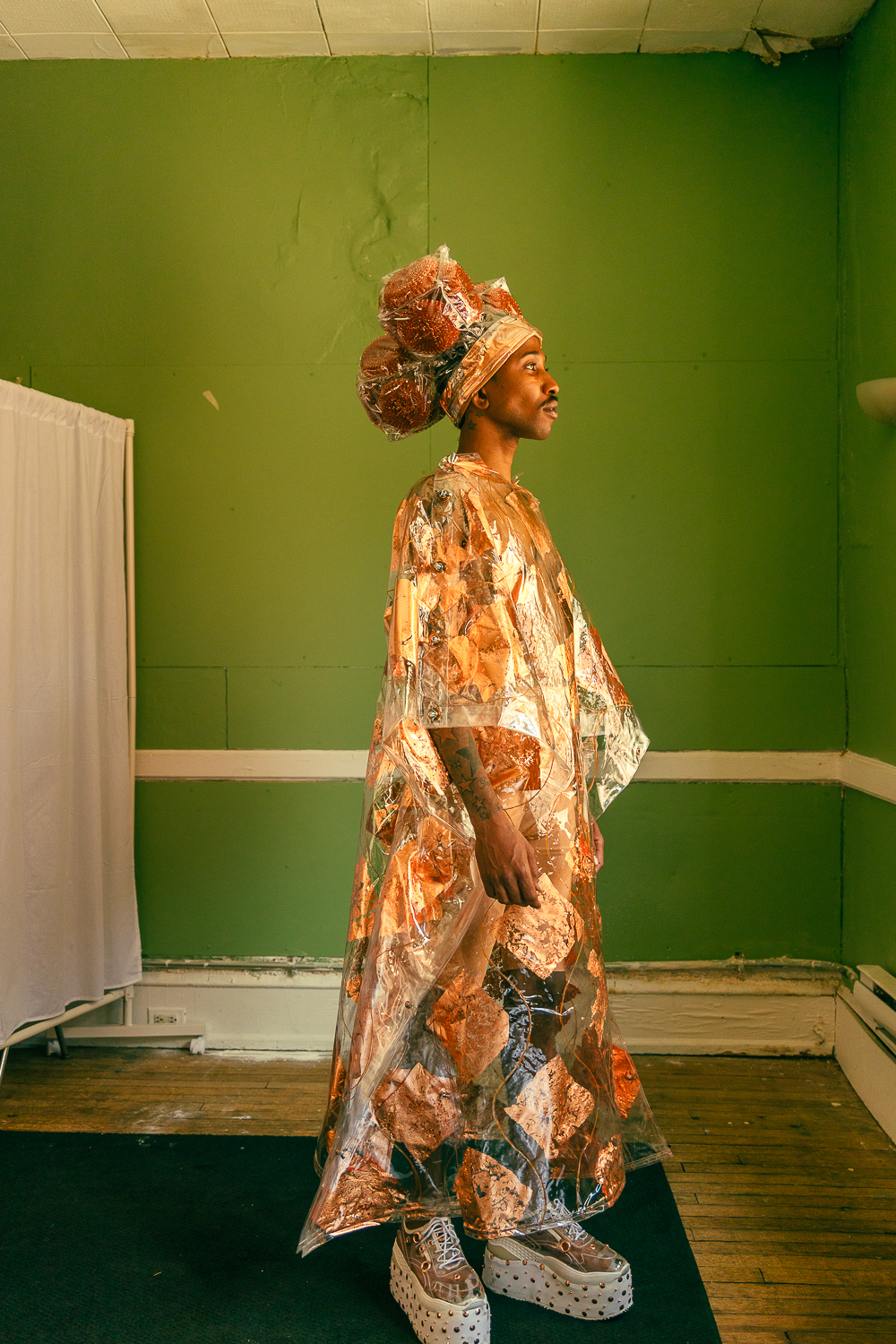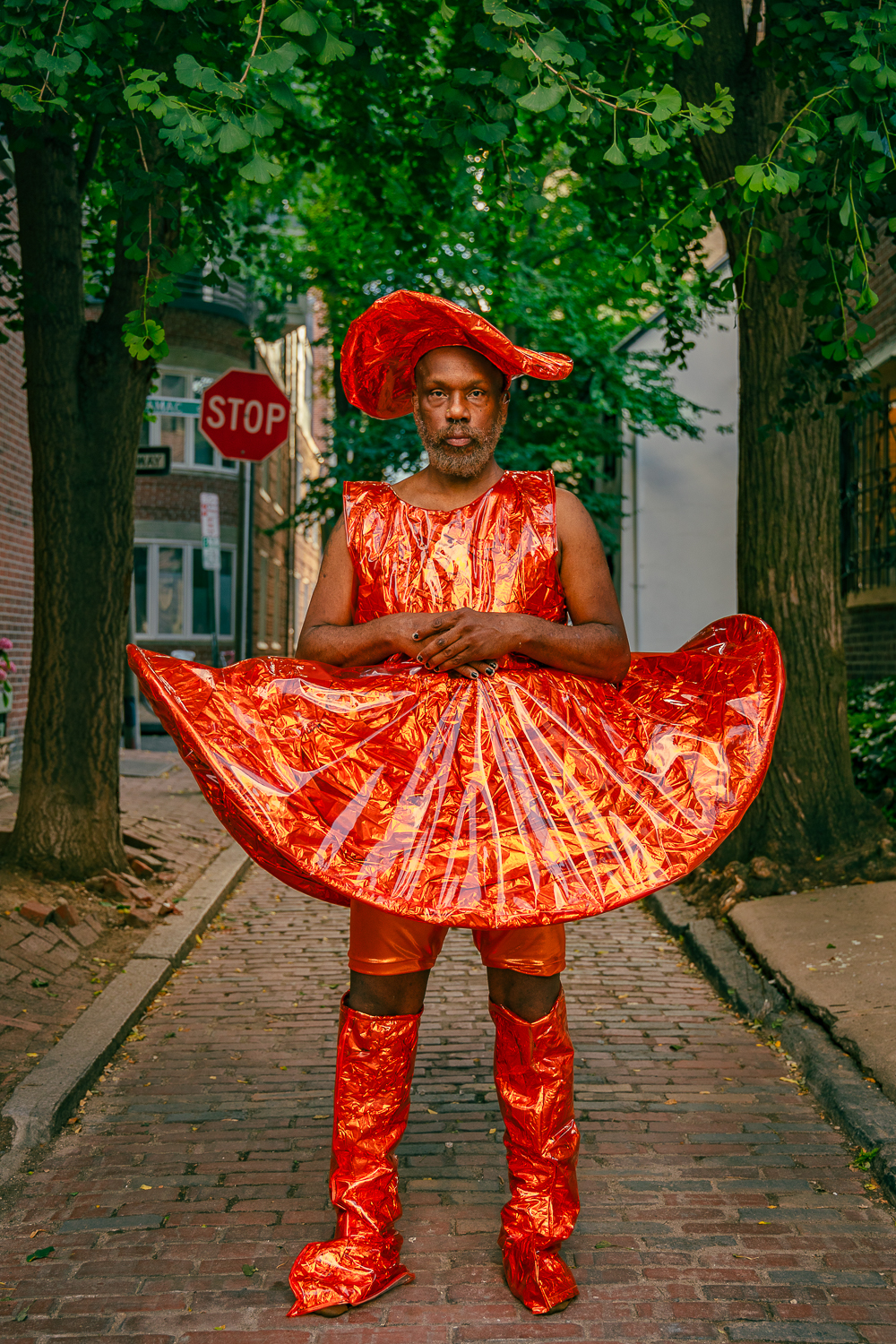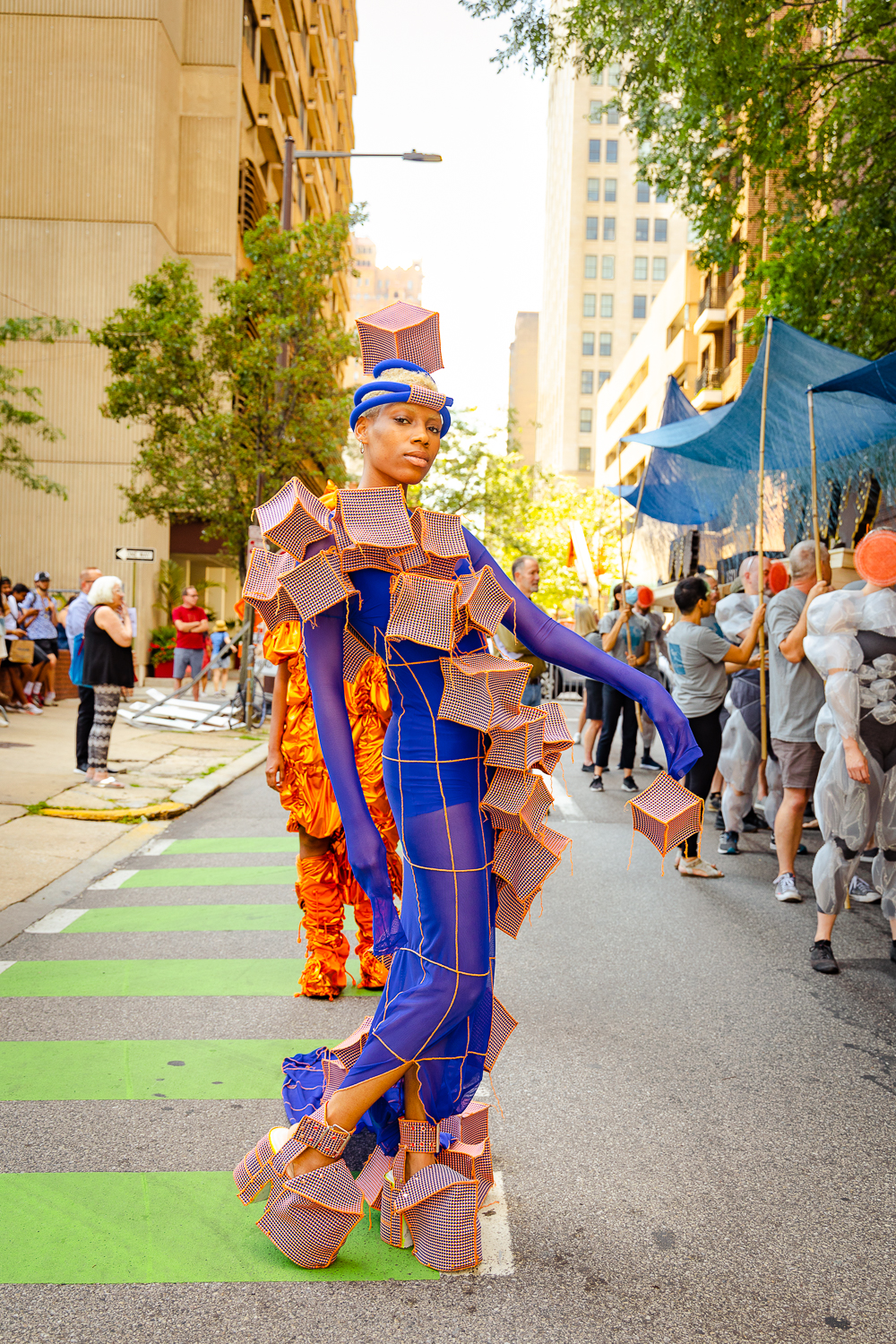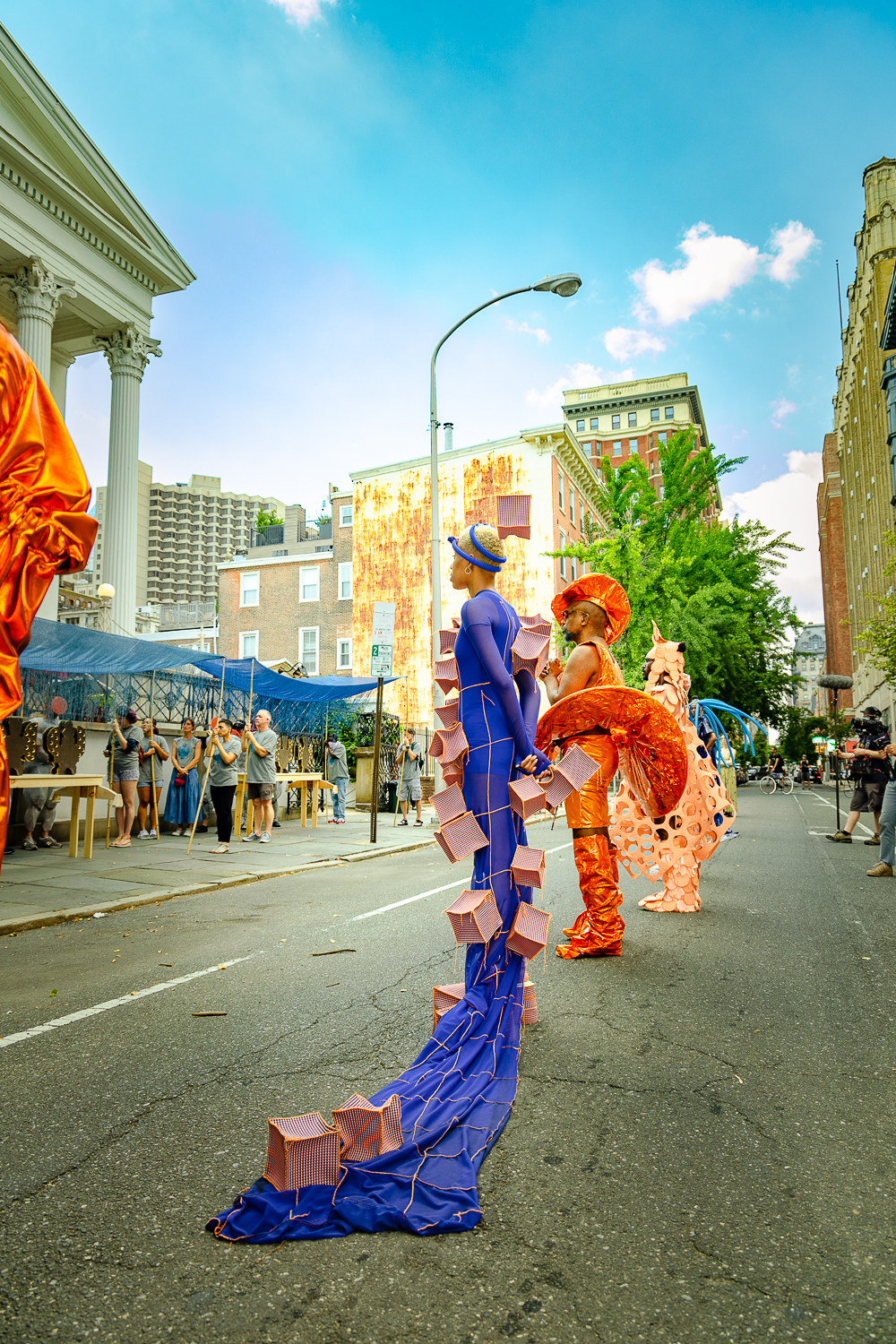Gone But Not Disrespected
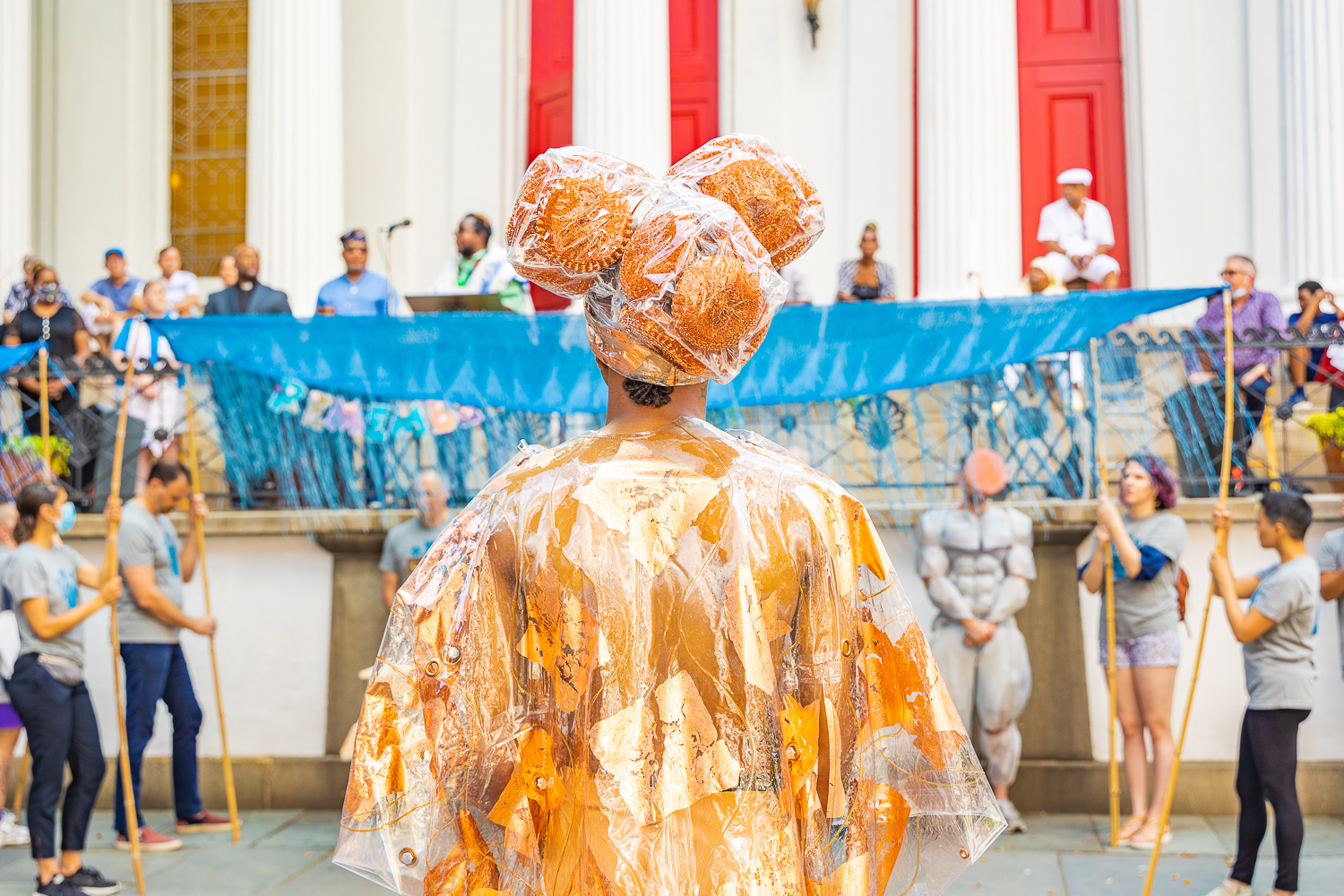
Claire Fleury, Copper Kaftan and Headpiece, 2022, vinyl, copper leaf, copper sponges, butterfly nuts and bolts [photo: Exum Fotografie; courtesy of the artist]
Share:
The Church of Saint Luke and the Epiphany is legendary for its reputation of being among the first places in Philadelphia to hold funerals for people who died with HIV. The church is also noteworthy for its architecture. The building sits upon a pedestal, its entrance set back from the street, creating a stagelike landing from which speeches can be made before crowds gathered below.
On the last Sunday in June 2022, a particularly hot day in Philadelphia, about 100 of us gathered in front of Saint Luke’s landing for the culmination of an experimental AIDS memorial called Gone and for Ever, a community-informed spectacle of sight, sound, and grief—part of Remembrance, a project of the William Way LGBT Community Center and funded by the Pew Center for Arts & Heritage—to grapple with the question of how to memorialize amid the ongoing crisis.
Outside Saint Luke’s were nine unique ceramic gold-leafed urns, created by artist Alex Stadler, who directed and conceived the event. When you think about the urns, imagine a brutalist interpretation of a butterfly or an elephant, intentionally thick and powerfully heavy. Each work weighs about 25 pounds.
In the central urn were ashes of paper upon which were written the names of more than 200 people lost to AIDS. These papers had been read aloud in private and burned in ceremony. The names were collected through community contacts and conversations, and online, over a series of months.
A procession bore the emotional weight of the urns and their contents. Before the procession, a brief memorial service occurred at the William Way LGBT Community Center. It included Untold Elegy, a commissioned musical piece composed by Kinan Adou-afach, and a suite of readings featuring authors who died with HIV. Philadelphia-based writers Anne Ishii, Michaela Majoun, and Abdul-Aliy A. Muhammad read works by Christopher Coe (d. 1994), Reinaldo Arenas (d. 1990), Melvin Dixon (d. 1992), and Cookie Mueller (d. 1989). The procession then departed for Saint Luke’s.
Claire Fleury, Blue Vinyl Coat and Headpiece, 2022, vinyl, grommets, balloons [photo: Exum Fotografie; courtesy of the artist]
Claire Fleury, Copper Kaftan and Headpiece, 2022, vinyl, copper leaf, copper sponges, butterfly nuts and bolts [photo: Exum Fotografie; courtesy of the artist]
Wooden tables, each holding three urns, were managed by pallbearers who emanated eroticism and strength in silver suits of soft armor created by designer The Henry. Leading the procession was a four-piece band—organized by Isiah Hammer—playing a deconstructed version of the Prince-penned hit “Nothing Compares 2 U,” made famous by Sinéad O’Connor. Following the band strode a cavalcade wearing a riot of shapes in shades of blue, orange, and rust, created by designer Claire Fleury. Three indigo shrouds, designed by Liz Collins, provided a canopy over the procession. Each one was finished with an underbelly of loose threads that swayed in the hot afternoon breeze.
Claire Fleury, Orange Dress with Hat and Chaps, 2022, vinyl, emergency blankets [Exum Fotografie; courtesy of the artist]
Claire Fleury, Cube Dress, 2022, mesh, car upholstery fabric, garden hose, wire, spandex [photo: Exum Fotografie; courtesy of the artist]
I was part of the procession that Sunday. I eventually perched on a brick planter in front of Saint Luke’s. Beside me sat a person, about a decade and a half older than my 42 years, clutching a photograph: a small cluster of men, grinning for the camera. They were beautiful in the way that so many people who die too early are beautiful—everything still moist, nothing is too hard or too soft. They appear nimble for a future. The person holding the photograph told me that the image was taken in 1990, and that by 1991 they had all died with HIV.
Up on the landing, above the urns, the pallbearers, the crowd, and even the shrouds, was a small, multifaith council of leaders. Among its members was Raquel Saraswati, who offered a Muslim funeral prayer, along with Chris Bartlett, William Way director and Radical Faerie, who led a round of song honoring the dead as ongoing influences among the living. Reverend Chris Kimmenez connected the profound sadness many people felt from not being able to comfort dying loved ones in the early days of Covid-19 to the stigma and loss in the early days of AIDS. Speaking near the end of the service, Reverend Andrea Lamour-Harrington offered the following culminating advice: “Small repair, our bodies are interconnected, be quick to love.”
A mourner brought a photo of friends. Within a year of the photo being taken everyone pictured died due to AIDS related complications [photo: Theodore Kerr]
Within their remarks, many of the speakers named people they knew in the Philadelphia area who lived and died with HIV, including ACT UP Philly member and prison activist John Bell (d. 2012); trans leader Jaci Adams (d. 2014); and founder of the Philadelphia Trans Wellness Conference, Charlene Arcila (d. 2015). These names were powerful to hear—reminders of mighty lives lived. But they also made the absence of names unuttered and unknown that much louder. What happens to a soul if it is given no place to rest? What happens to a community when mourning is left unfinished?
—
I had my own reasons for attending Gone and for Ever. In my work as an AIDS organizer, I write about Robert Rayford, who died with HIV in 1969. Every year—and for the last six years—I go to St. Louis, where Rayford lived. It was from there, in June, that I left to attend Gone and for Ever. The afternoon before my flight, I visited Washington Park Cemetery, near the city’s airport, where Rayford´s death certificate indicates he is buried.
Washington Park, once the largest cemetery for Black people in the area, was, in its early days, an example of the lawn park tradition wherein cemeteries were intended as places of middle- and upper-class respite. It is now plagued by decades of neglect and mismanagement. Tombstones are toppled, debris is tangled in overgrown vines. As the airport and MetroLink were built, whole areas of Washington Park were displaced. Many graves were disinterred and relocated within the cemetery, often with no proper records of whose remains went where. In the last 10 years, community members and families of the buried have been trying to create order amid this death and chaos. At the intersection of these forces, I can’t find Rayford’s grave.
Claire Fleury, Cube Dress, Orange Dress, Felt Dress, 2022, mixed materials [photo: Exum Fotografie; courtesy of the artist]
Not until 1981 did people begin paying attention to a once-mysterious illness that would come to be known as HIV/AIDS. An attentive young professional, Dr. Michael Gottlieb, sounded the alarm when he noticed young men, mainly White and gay, were being stricken by illnesses that previously affected only cats and old Mediterranean men. From there, the rest, we can say, is history.
But what about the people who died before history, who, unlike Robert, remain unknown? Among the early deaths related to AIDS were people who injected drugs, who didn’t have proper housing, who lacked access to adequate health care. They were people whose deaths—unlike those of young White men in 1981—did not shock the system into action. Disrespected too often in life, must they also be forsaken in death?
Stadler says Gone and For Ever is dedicated to those lost and unclaimed casualties of the AIDS pandemic’s early years. In my mind, they include those souls whose remains were left unclaimed at hospitals and funeral homes, as well as people whose deaths have not yet been counted or mourned. Gone and For Ever is, to borrow Lamour-Harrington’s words, a small repair, an act of connection between the living and the dead, and an opportunity to honor those whose names we know and remember—and people whose names we may never know—who lived and died with HIV.
Theodore (ted) Kerr is a writer, organizer, and educator. He is the co-author of We Are Having This Conversation Now: The Times of AIDS Cultural Production (Duke, Fall 2022) with Alexandra Juhasz. He is the 2022 ISSUE Project Room Curatorial Fellow. He is a founding member of the collective, What Would an HIV Doula Do? He teaches at Manhattan College and The New School.
